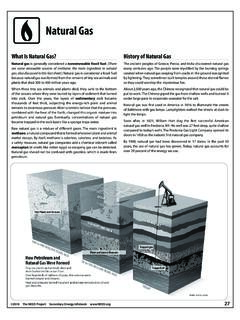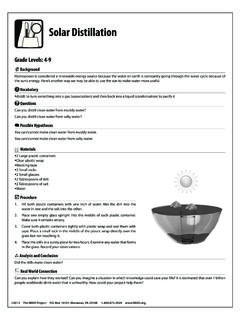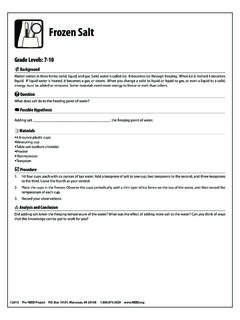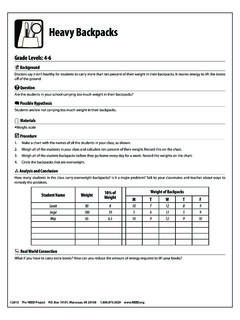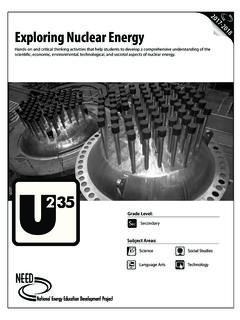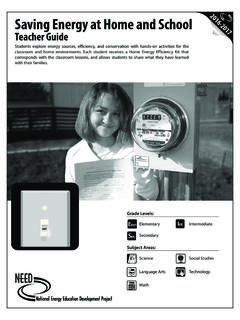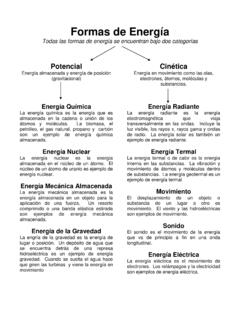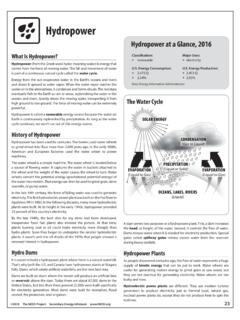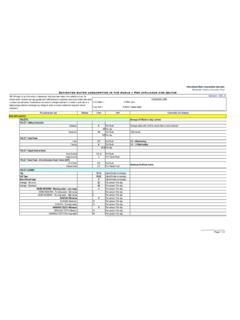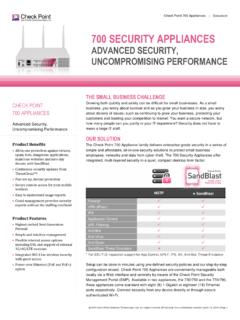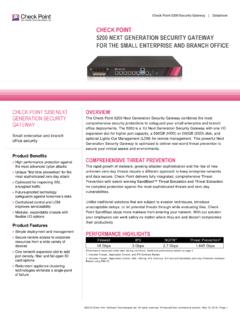Transcription of Energy Consumption - NEED
1 OFF Energy Consumption Energy Use Think about how you use Energy every day. You wake up to an alarm clock. You take a shower with water warmed by a hot water heater. Energy Consumption by Sector, 2015. You listen to music on the radio as you dress. You catch the bus to TRANSPORTATION RESIDENTIAL school. That's just the Energy you use before you get to school! Every Top Residential Sources: Top Transportation Sources: Natural Gas day, the average American uses about as much Energy as is stored Biomass Petroleum . in about seven gallons of gasoline. Energy use is sometimes called Biomass Petroleum Energy Consumption . Natural Gas INDUSTRIAL ELECTRIC POWER Who Uses Energy ?
2 Top Industrial Sources: Natural Gas Top Electric Power Sources: COMMERCIAL Coal . The Department of Energy divides Energy users into different Petroleum Top Commercial Sources: Naturals Gas Propane Natural Gas Uranium categories: residential, commercial, industrial, electric power, Petroleum and transportation. These are called the sectors of the economy. Propane The residential, commercial, and industrial sectors use electricity. This graph Residential and Commercial Sectors depicts their Energy source Consumption outside of electricity. Data: Energy Information Administration *Total does not equal 100% due to independent rounding. Any place where people live is considered a residential building.
3 Commercial buildings include offices, stores, hospitals, restaurants, and schools. Residential and commercial buildings are often grouped Lighting together because they use Energy in the same ways for heating Homes and commercial buildings also use Energy for lighting. The and cooling, lighting, heating water, and operating appliances. average home spends five percent of its utility costs on lighting. Schools, stores, and businesses use between 9 and 10 percent Together, homes and buildings consume almost 11 percent of of their utility costs for lighting. Most commercial buildings use the Energy used in the United States today. In the last 30 years, fluorescent lighting.
4 It costs more to install, but it uses a lot less Americans have reduced the amount of Energy used in their homes Energy to produce the same amount of light. and commercial buildings. We still heat and cool rooms, and heat hot water. We have more home and office machines than ever. Most Many homes still use the type of light bulb invented by Thomas of the Energy savings have come from improvements in technology Edison over 100 years ago. These incandescent bulbs are not very and in the ways the equipment is manufactured. efficient. Only about 10 percent of the electricity they consume is converted into light. The other 90 percent is converted to heat. Heating and Cooling Due to the Energy Independence and Security Act of 2007, most It takes a lot of Energy to heat rooms in winter and cool them in traditional, inefficient incandescent light bulbs have been phased out summer.
5 Forty-eight percent of the Energy used in the average home and are no longer for sale. Consumers can choose from several more is for heating and cooling rooms. The three fuels used most often for efficient bulb options as replacements. Energy -saving incandescent, heating are natural gas, electricity, and heating oil. Today, more than or halogen, bulbs are more expensive than traditional incandescent, half the nation's homes use natural gas for heating. but use 25 percent less Energy and last three times as long. Most natural gas furnaces in the 1970s and 1980s were about 60 Compact fluorescent light bulbs (CFLs) can be used in light fixtures percent efficient.
6 That means they converted 60 percent of the throughout homes. CFLs cost less to use because they last longer Energy in the natural gas into usable heat. New gas furnaces are and use less Energy than incandescent bulbs. designed to be up to 98 percent efficient. Even more efficient than CFLs, light emitting diodes (LEDs) are The second leading fuel for home heating is electricity. Electricity available. LEDs have become a very affordable option for lighting also provides almost all of the Energy used for air conditioning. The in homes and businesses, and use even less Energy than CFLs. efficiency of heat pumps and air conditioners has increased more LEDs last 25 times longer than a traditional incandescent, are more than 50 percent in the last 35 years.
7 Durable than the other options available on the market, and have Heating oil is the third leading fuel used for home heating. In 1973, many technical applications. the average home used 1,300 gallons of oil a year. Today, that figure is about 517 gallons, a significant decrease. New oil furnaces burn oil more cleanly and operate more efficiently. In the future, we may see more use of renewable Energy sources, such as geothermal and solar Energy , to heat and cool our homes and workspaces. 2017 The NEED Project 8408 Kao Circle, Manassas, VA 20110 45. Appliances Over the last 100 years, appliances have changed the way we Lighting Efficiency spend our time at home.
8 Chores that used to take hours can now be done in minutes by using electricity instead of human Energy . In descent 1879 Incandescent 14 MAXIMU LUMENS PER WATT. MAXIMUM. Today's Efficient fficient 1990, Congress passed the National Appliance Energy Conservation Halogen Incandescent d descent 22. Act, which requires appliances to meet strict Energy efficiency standards. As a result of this Act, home appliances have become Today's y's CFL 70. more Energy efficient. Water heaters, refrigerators, clothes washers, and dryers all use much less Energy today than they did 25 years Today's y's LED 100. ago. Today's Fluorescent 110. Appliance Efficiency Ratings Data: Madison Gas and Electric When you buy an appliance, you should pay attention to the yellow EnergyGuide label on every appliance.
9 This label tells you the Energy Efficiency Ratio (EER) of the appliance. The EER tells how ENERGYGUIDE LABEL. much it costs to operate the appliance. Government Federal law prohibits removal of this label before consumer purchase. Payback Period Whether you buy a furnace, hot water heater, refrigerator, or other home appliance, you must choose the best bargain. Since Water Heater - Natural Gas xx Corporation most high-efficiency systems and appliances cost more than less Tank Size (Storage Capacity): 50 gallons Model XXXXXXX. efficient ones, you have to know how much it will cost to operate the appliance each year and how many years you can expect to use it.
10 The payback period is the amount of time you must use a system Estimated Yearly Energy Cost or appliance before you begin to benefit from Energy savings. For example, if you buy an efficient refrigerator that costs $100. more, but uses $20 less electricity each year, you would begin $240. saving money after five years. Your payback period would be five years. Since refrigerators usually last ten years, you would save $100 $225 $275. over the life of the appliance and save natural resources. Cost Range of Similar Models First Hour Rating (How much hot water you get in the first hour of use). very small low medium high 90 Gallons l Your cost will depend on your utility rates and use.
